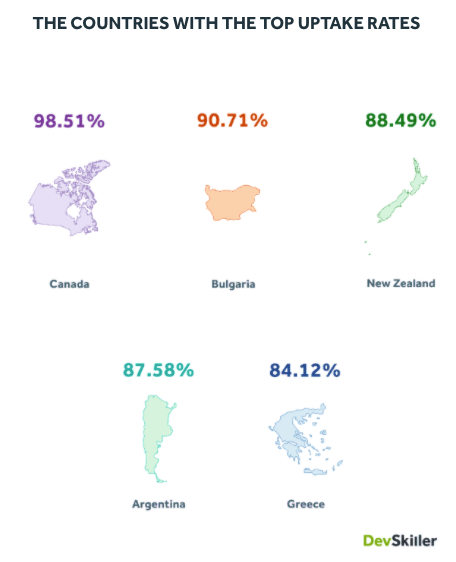The COVID-19 pandemic changed the way the tech industry works and how talent in the industry is recruited. With offices closed down, almost all tech employees are working remotely.
While the industry had been, for the most part, familiar with remote work, the sudden shift away from offices accelerated many trends and forced even remote-friendly companies to pursue more permanent policies and hiring flexibility. This has opened up where companies can recruit talent, but made working with those remotely distributed coworkers more complicated.
Every year at DevSkiller, we gather a plethora of data about developers, companies hiring developers, and the technologies used. This data forms the basis of our annual IT skills report. This year, our report sees both subtle and not-so-subtle changes in recruitment trends, thanks to the uptick in remote work.
This article summarizes trends and other observations from the state of tech recruiting in the last year. You can find the full, free, and ungated report here.
More countries are looking abroad
The following countries increased the rate at which they hire foreign talent:
- Italy - 39.42%
- Australia - Increase of 32.08%
- The United Kingdom - Increase of 29.91%
- Canada - Increase of 26.44%
- Indonesia - Increase of 12.37%
These rises may be due to the lack of local talent, the opportunity to hire better talent for less, or the fact that remote work has empowered recruiters to rely on foreign tech talent more than in previous years.
International tech recruitment in the US
According to the report, the US had a decrease in international hiring compared to the 2020 report. However, US companies still accounted for approximately 25% of all international developers tested on our platform.
There are two possible theories explaining why the US didn’t follow the same hiring trends as other major markets globally:
Market uncertainty
As noted in our IT Skills report, tech employee turnover in the US was significantly lower than the previous year (down approximately 35%), according to the Bureau of Labor Statistics. Job market uncertainty from the recent presidential election and the impact of COVID-19 meant that developers were changing jobs at a much lower rate than in previous years. Juggling work with childcare and the inability to meet potential employers in-person may also have contributed to a reluctance to change positions in 2020.
Internal mobility
Another correlating factor may be that US companies are becoming more focussed on internal mobility and reskilling their existing workforce. The Coronavirus pandemic has shifted the way organizations view and manage their internal talent. Companies have started to realize that reskilling their employees is far cheaper than recruiting someone new. In fact, according to LinkedIn, there has been a 20% increase in internal mobility since COVID-19 arrived in the US.
US sources of international talent
As they did last year, US companies tested the most international candidates on the platform. However, US developers are only the fifth-largest labor market in terms of the number of local developers tested on our platform. This continues a downward trend in which we saw the US drop from second to fourth position in our last report. Although at first glance this seems like a criticism of developers from the US, it is more a testament to the quality of developers from other markets.
US companies favor international talent from:
- Canada
- Dominican Republic
- Poland
- Portugal
- Australia
It is no accident that Canada and the Dominican Republic made the top five. The proximity and relative time difference makes them desirable for US companies to source developers.
Despite US developers falling out of favor somewhat, companies from the UK still prefer US developers. The top five countries that UK companies recruit from are:
- United States of America
- Austria
- Poland
- Italy
- China
Rounding out the top five were Austria, Poland, Italy, and China—an interesting mix, given the UK’s separation from the EU.
International hiring increased significantly
The pandemic caused a massive shift in company hiring patterns. Most companies transitioned to remote-friendly work almost overnight, which opened the door to more international hires.
Our tech recruitment certification course saw a massive spike in April and May of 2020, right after the lockdown was announced in most countries. This trend may have signalled a belief among job seekers that the IT industry would be less affected by the pandemic than others and recover more quickly. It may also reflect the ease with which one can train and work in software remotely.
The surge in certifications also tells us that recruiters wanted to improve their tech industry knowledge to make better hires.
Over half (52%) of those who took the course passed on the first try as opposed to 22% last year, indicating that recruiters are studying harder than ever. It takes on average 43 days to get tech certified, on par with last year’s results.
Developers took more tests
In 2020, 94% of developers finished a coding test sent to them, up from 93% in the previous year. This number has grown steadily over the past few years, pointing out that developers are taking coding tests more seriously.

We also saw the highest uptake rates ever in the past year. Just under 70% of tests sent were undertaken by candidates, up from 41% last year. This increase in uptake is undoubtedly due to the COVID-19 outbreak. Candidates forced into unemployment or unsure about their future are not ignoring coding invitations.
In conclusion
COVID-19 changed how people around the world lived, and recruiting for candidates changed with it. Many companies went entirely remote and their recruitment efforts went global to reflect that. The US accounted for one quarter of the total international hires and was the main source of hires for international companies, but that rate of hiring was down possibly as US workers sought security in uncertain times. And a surprisingly large number of candidates were willing to take skills tests as part of their applications.
The annual IT skills report can help you quickly identify the top recruiting trends of the last year as a way to improve your search and recruitment of tech talent.
In the free report, you’ll find more information about:
- International recruitment
- Popular IT skills
- Highest-scoring candidates
- The most popular browser and OS systems
You’ll also find an in-depth guide and the methodology used for this study.
